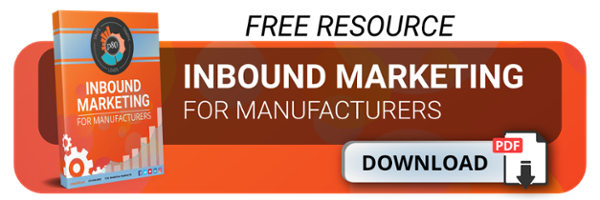Inbound Marketing Blog
for Manufacturers and Healthcare Companies
Trade Show Marketing: The Transition to Digital Marketing

Trade shows used to be the lifeblood of lead generation efforts for many manufacturers.
But now, with the COVID-19 pandemic forever changing the relevance of trade shows across the country, manufacturers are feeling the pain of stagnating lead generation.
Traditional Dependence on Trade Show Marketing
Trade shows are big business. And trade show marketing is constantly evolving in this ever-changing market affected by the ongoing pandemic.
Pre-COVID, around 13,000 trade shows were held across the country annually. At the beginning of 2020, the U.S. trade show market was projected to reach $16.4 billion, up from $15 billion in 2019.
Many B2B companies have come to depend on trade show marketing as a major component of their lead generation efforts. Trade shows have become the second-largest and fastest growing source of annual revenue with new leads.
Being dependent on trade shows for lead generation is essentially putting all your new-prospect eggs into one trade show basket. While one trade show being cancelled or postponed is bad enough, what happens when all of them are indefinitely and begin to walk toward the light of irrelevance? We’re seeing that right now.
However, the slowing popularity and effectiveness of physical trade shows presents an opportunity.
Inbound marketing can pick up the slack in lead generation and become a permanent source of opportunities in your sales funnel.
From Trade Show Marketing to Inbound Marketing
Manufacturers that have invested in an inbound marketing strategy have a pipeline for lead generation that’s always on, even when a major event shuts things down. Those without an inbound marketing strategy are playing catch-up or figuring out alternative ways to reach new prospects without trade show marketing.
Regardless of world events, a steady stream of content coupled with an inbound marketing strategy ensures that prospects are being reached. More importantly, prospects are coming to you while on their buyer’s journey, rather than your sales and marketing team having to seek them out through traditional marketing channels, like trade shows.
Advantages of Inbound Marketing
Transitioning efforts and resources meant for trade shows to inbound marketing doesn’t have to be a permanent either-or scenario for your business. For right now, it makes sense. And if you're looking for a potential long-term solution to loss of lead generation, then inbound marketing is a great solution.
Many elements of your traditional trade show marketing strategy can easily -- and seamlessly -- convert to the world of digital marketing. In fact, there are many advantages that come with replacing physical trade show marketing with inbound marketing:
- Your website is a 24/7 trade show booth
- Website traffic = trade show foot traffic
- Educational content is easy to present
- Lead nurturing and engagement is simplified
Your Website is a 24/7 Trade Show Booth
Unlike a trade show booth, your website is always open to strike up a relationship with a prospect. It should treat visitors like your trade show booth and team do.
When evaluating your website, ask yourself questions like:
- Is your website welcoming and user friendly?
- Is your website set up to deliberately/strategically drive conversations?
- Does it represent your company and the value you provide clearly?
Website Traffic = Trade Show Foot Traffic
At trade shows, hundreds, if not thousands, of prospects walk by your booth. How do you get them to stop by for a few minutes?
Just like at your booth, there has to be value for visitors to spend time on your website. How do you engage them to stay on it? Is it with an offering:
- Promotional products?
- Free content giveaways?
- Product demonstrations?
- Consultations?
Your company pays good money for booth space -- sometimes top dollar for a premium spot. The same can apply to search engine traffic through PPC (pay per click), which drives qualified traffic to your website.
Additionally, you should be producing valuable content that Google deems worthy of a page 1 listing. More on that in the next section.
Educational Content Is Easy to Present
Almost all exhibitors at trade shows provide some sort of educational material for attendees.
Your website should be full of material that’s useful to visitors. Much of this content can be blogs that directly address what prospects commonly ask -- especially the questions prospects ask before contacting a sales person. The more quality blogs answering those FAQs, the better -- Google can take notice and increase your website’s ranking.
Your website should also provide opportunities for visitors to take a deeper dive into their information-gathering process, such as a consultation or demo similar to what they’d get at a trade show. These online interactions provide a conversion opportunity, which generates a lead.
Lead Nurturing and Engagement Is Simplified
Trade show marketing starts before the actual event to generate buzz and get attendees excited to visit your booth.
Like your pre-show marketing, you should leverage your existing contact database to get your content in front of existing leads/customers/contacts. Your blogs and premium offers are a great place to start.
You should also be proactive in making those 1-on-1 connections with new leads. Just like you would after a trade show, follow up with a prospect -- connect with them on LinkedIn and shoot them a quick email.
Resource: Here are 5 Follow-up Email Templates for Trade Shows that can be repurposed.
In Tandem With Inbound Marketing
Uncertainty of when in-person trade shows will return doesn’t have to mean uncertainty for your business. Though the physical world has slowed down, your marketing and lead generation efforts can run full-tilt with inbound marketing in the thriving digital world.
What’s more, an inbound marketing strategy can still be part of your marketing repertoire even after trade shows are back in full swing. To learn more about inbound marketing for manufacturers, download our free guide below:
Editor's note: This article was originally published in April 2020 and has recently been updated.
Our Blogs, Direct to Your Inbox!
How to Audit your Online Marketing
If you are executing digital marketing, congratulations! You are most likely already one step ahead of your competition, and making strides to meaningfully connect with prospects online. But, how do you know if you’re seeing continual success year over year, and improving your metrics?
Without the tools in place to analyze and benchmark your efforts, it is impossible to scale your online marketing and ensure continuous success.


